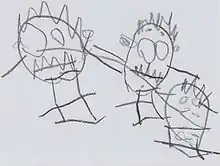
A tadpole person[1][2][3] or headfooter[4][5] is a simplistic representation of a human being as a figure without a torso, with arms and legs attached to the head. Tadpole people appear in young children's drawings before they learn to draw torsos and move on to more realistic depictions such as stick figures.
Preschoolers who draw tadpole people will generally not draw torsos, even when instructed to include features that are part of the torso, such as a belly button. Instead, they tend to draw the feature onto the tadpole person without modifying the figure.[6][7]
Clinical significance

In cognitive tests such as the Draw-a-Person test, the drawing of tadpole people by adults may indicate a cognitive impairment. For example, patients with dementia tend to draw tadpole people when tasked to draw human figures.[8]
In art

The early work of Austrian artist Oswald Tschirtner often contained headfooters.[9][10]
The Last Judgment by Hieronymus Bosch features a gryllos that shares features with headfooters.
See also
References
- ↑ Freeman, N.H. (3 April 1975). "Do children draw men with arms coming out of the head?". Nature. 254 (5499): 416–417. doi:10.1038/254416a0. S2CID 4269922. Retrieved 2023-11-15.
- ↑ Bassett, Elizabeth M. (1977). "Chapter 3: Production Strategies in the Child's Drawing of the Human Figure: Towards an Argument for a Model of Syncretic Perception". In Butterworth, George (ed.). The Child's Representation of the World. Plenum Press. pp. 49–59. ISBN 0306310252.
- ↑ Spensley, Fiona; Taylor, Josie (1999). "The Development of Cognitive Flexibility: Evidence from Children's Drawings". Human Development. 42 (6): 300–324. doi:10.1159/000022639. JSTOR 26763422. S2CID 29015414. Retrieved 2023-11-15.
- ↑ ter Laak, J.; de Goede, M.; Aleva, A.; van Rijswijk, P. (2005). "The Draw-A-Person Test: An Indicator of Children's Cognitive and Socioemotional Adaptation?". The Journal of Genetic Psychology. 166 (1): 77–93. doi:10.3200/GNTP.166.1.77-93. hdl:1874/27790. PMID 15782679. S2CID 12572911. Retrieved 2023-11-15.
- ↑ Seidel, Christa (November 3–7, 2010). Model for Interpreting Drawings and its Application in the Hospital School (PDF). 7th Hope Congress. Munich.
- ↑ Coté, Carol A.; Golbeck, Susan (2007-08-13). "Pre‐schoolers' feature placement on own and others' person drawings". International Journal of Early Years Education. 15 (3): 231–243. doi:10.1080/09669760701516868. S2CID 143866588. Retrieved 2023-03-20.
- ↑ Boyatzis, C.J.; Michaelson, P.; Lyle, E. (1995). "Symbolic immunity and flexibility in preschoolers' human figure drawings". The Journal of Genetic Psychology. 156 (3): 293–302. doi:10.1080/00221325.1995.9914824. PMID 7595423. Retrieved 2023-03-20.
- ↑ Ericsson, Kjerstin; Hillerås, Pernilla; Holmen, Karin; Winblad, Bengt (1996). "Human-figure drawing (HFD) in the screening of cognitive impairment in old age". Journal of Medical Screening. 3 (2): 105–109. doi:10.1177/096914139600300212. PMID 8849770.
- ↑ "Oswald Tschirtner". Raw Vision. No. 2. 1989. p. 32.
- ↑ Maizels, John (2000-09-20). Raw Creation: Outsider Art and Beyond. Phaidon Press. p. 90. ISBN 978-0714840093.